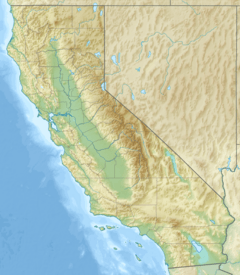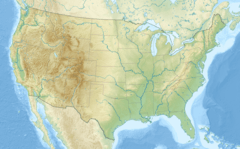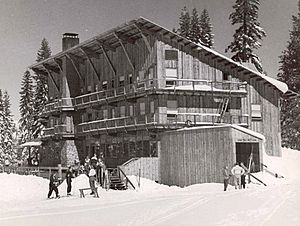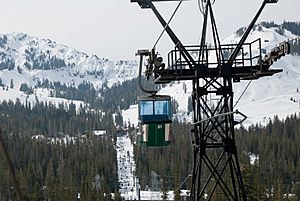Sugar Bowl Ski Resort facts for kids
Quick facts for kids Sugar Bowl Resort |
|
|---|---|
 |
|
| Location | 629 Sugar Bowl Rd, Norden, CA 95724 |
| Nearest city | Norden, California |
| Coordinates | 39°18′16″N 120°20′09″W / 39.30444°N 120.33583°W |
| Top elevation | 8,383 ft (2,555 m) |
| Base elevation | 6,883 ft (2,098 m) |
| Skiable area | 1,650 acres (670 ha) |
| Runs | 103 total |
| Longest run | 3 mi (4.8 km) |
| Lift system | 13 lifts (5 high speed quads, 3 quads, 1 triple chair, 1 gondola, 3 surface lifts |
| Lift capacity | 21,740 passengers/hr |
| Snowfall | 500 in (1,300 cm) |
| Website | www.sugarbowl.com |
Sugar Bowl is a super cool place for skiing and snowboarding! It's located in northern Placer County, close to Norden, California, high up in the Sierra Nevada mountains. It's about 46 mi (74 km) west of Reno, Nevada, right off Interstate 80. This awesome resort first opened its doors on December 15, 1939.
Sugar Bowl is a medium-sized ski area in the famous Lake Tahoe region. People love it for its long history, challenging slopes for advanced skiers, and tons of snow every year. It's also one of the closest ski spots to the San Francisco Bay Area. The mountain has slopes for everyone: 17% are for beginners, 45% for intermediate skiers, and 38% for advanced adventurers.
A famous Austrian skier named Hannes Schroll and some friends started Sugar Bowl. It's special because it's one of the few ski resorts in the Lake Tahoe area that is still privately owned. Sugar Bowl was also the first ski area in California to get a chairlift. Plus, it was the first on the entire west coast to have a gondola lift!
Contents
A Look Back: Sugar Bowl's History
Mountain Land and Early Travelers
The mountains where Sugar Bowl is now, Mt. Judah and Mt. Lincoln, were once part of a path for American pioneers in the 1800s. A section of the California Trail called Roller Pass ran right between Mt. Judah and Mt. Lincoln. This was a wagon trail through Donner Pass used by settlers and gold seekers traveling from the eastern United States across the Sierra Nevada. Today, you can still explore this pass using the Pacific Crest Trail or the Mt. Judah Loop trail, which Sugar Bowl created in 1994.
Trains first started coming to Donner Pass in 1868. This happened after the First transcontinental railroad was finished across the United States. Later, in 1925, a new tunnel called The Big Hole tunnel was built through Mt. Judah. This two-mile (3 km) tunnel helped protect trains from heavy snowstorms. Even with the tunnel, winter blizzards often made train travel difficult through the pass.
In 1894, a historian named Charles F. McGlashan thought a winter carnival would bring more visitors. He built the first Ice Palace by hand to attract tourists from the trains. Soon, the railroad started running "Snowball Specials" to Truckee from the Oakland Pier.
Getting to the Mountains
It became easier for tourists to reach the area in 1913 when the Lincoln Highway opened. This was the first road to cross the entire United States, going right over the Donner Pass. The road was improved in 1926 and became U.S. Route 40. However, the state of California didn't start plowing snow until 1932, so winter car travel was still tricky.
In 1924, the famous actor Charlie Chaplin filmed parts of his silent movie The Gold Rush on Mt. Lincoln. Six hundred men were brought in by train from Sacramento to act as extras in a funny scene.
The land that Sugar Bowl sits on was bought in 1923 by Stephen and Jennie Pilcher. They paid $10.00 for 700 acres (2.8 km2) of land from the Southern Pacific Railroad. Before Sugar Bowl had chairlifts in the 1930s, skiers had to climb up the mountain peaks like Mt. Lincoln on foot to ski down. By the mid-1930s, there were some rope tows on the hillsides around Donner Pass.
In 1936, Austrian ski instructors Bill and Fred Klein opened a ski school. They taught skiers from the Sierra Club and local areas. The Klein brothers and their instructors often taught over 100 students each weekend. They would even take advanced students up to Mt. Lincoln on foot. More people were getting into skiing, and better roads made it easier to travel. People in America also had more free time after new labor laws in the 1930s. The 1932 Winter Olympics in Lake Placid, New York, also made skiing more popular.
How Sugar Bowl Began
In 1937, the Pilcher sisters decided to sell their 700 acres (2.8 km2) of land around Mt. Lincoln and Hemlock Peak. Bill Klein remembered his friend Hannes Schroll, a famous Austrian ski champion and instructor working in Yosemite. Klein told Schroll about the land for sale. Schroll, who was known for yodeling while skiing, came to visit. He and Klein were amazed that the steep, rocky slopes would soon be covered in snow.
By March 1938, Schroll made a deal to buy the land for $6,740. But he couldn't get his money from Austria because of the war. So, he borrowed money from a local realtor, Hamilton McCaughey, and ice-skating champion George Stiles. Schroll also sent a telegram to Walt Disney for funding, but Disney was away and didn't get it in time.
Schroll became president of the Sugar Bowl Corporation in 1938. He had help from Wellington Henderson, Sherman Chickering, and Donald Gregory. Schroll then looked for other investors to help build a ski-in/ski-out village and resort. He wanted it to look like the villages in his hometown of Kitzbühel, Austria. Schroll and Klein decided to name the resort "Sugar Bowl" because the fine, sparkling snow looked like sugar.
The Southern Pacific Railroad agreed to build a facility next to the Norden telegraph office. This would help accommodate 600 people for Sugar Bowl's opening. Walt Disney, who had taken ski lessons from Schroll, was asked for funding again. He became a shareholder by giving Schroll $2,500. To thank Disney, Schroll changed the name of "Hemlock Peak" to "Mt. Disney." Soon, others invested too, and Schroll raised $75,000 by June 1939 to start building the resort. Schroll also used his Hollywood connections to get Metro-Goldwyn-Mayer to make a film called "Snowbirds" in November 1938, before Sugar Bowl even opened.
Construction of the Sugar Bowl lodge and the first chairlift began in the summer of 1939. The lodge was designed with a sloped roof so snow would slide off easily. The chairlift was designed by Henry Howard and built by the Riblet Tramway Company. Miners from Nevada City helped clear trees and dig foundations for the 13 towers by hand. They even used dynamite sometimes!
Sugar Bowl officially opened on December 15, 1939. However, there wasn't enough snow for skiing yet. So, a temporary ice rink was quickly set up for everyone to enjoy. Two weeks later, on January 4, 1940, a huge blizzard hit Sugar Bowl, and skiers started flocking to the resort.
Exciting Times After Opening
Near the end of Sugar Bowl's first ski season, Schroll held the first Silver Belt race in April 1940. Gretchen Fraser and Friedl Pfeifer won the race. Before the international World Cup ski competition, the Silver Belt race was known as one of the toughest. It attracted the best European and American skiers. Jannette Burr and Christian Pravda were the only ones to win the race three times. Many other famous skiers also won this challenging race.
Because Sugar Bowl had the first chairlift in the Sierra Nevada mountains and a full lodge, it quickly became a popular spot. Many famous guests and Hollywood stars visited. People enjoyed storytelling, dancing on the deck, and dressing up for dinner. Guests included actors like Robert Stack, Norma Shearer, and Marilyn Monroe. Actress Janet Leigh was even discovered at Sugar Bowl! Her father worked at the front desk, and actress Norma Shearer saw Janet's photo there.
The movie Two-Faced Woman, starring Greta Garbo, was filmed at Sugar Bowl in the spring of 1941. Sugar Bowl was also featured in the 1941 Disney cartoon The Art of Skiing. Schroll is even credited with the famous yodel that Goofy makes in the cartoon, now known as the Goofy holler.
Operations at the resort paused when the United States joined World War II. There were very few guests, and Schroll stepped down as president of Sugar Bowl in 1945. The "Snowball Specials" train service also stopped.
After the War Years
Bill Klein returned to Sugar Bowl in 1946 as the ski school director. He stayed in that role until 1957. Klein thought skiing was a stylish sport and opened his own ski shop at the lodge. Howard Head, who invented the first metal skis, asked Klein to test his new skis. He even offered Klein a share in his company. Klein said no at the time, but later regretted it when Head's company became a top ski maker.
A second chairlift was added to Sugar Bowl in 1950. This new double-chair lift opened up more slopes on Mt. Lincoln without needing to hike. Two years later, in 1952, the original ski lift on Mt. Disney was replaced.
Based on the original plans, Jerome Hill decided a gondola was needed to move people better into the ski area. In 1953, "The Magic Carpet" was installed. This was the first aerial tramway on the west coast! The Gondola has been rebuilt and improved twice since then. It takes guests from a parking lot, over the train tracks, and right into the main village.
The 1960s brought a new era for skiing in the Sierra Nevada. This was especially true after the 1960 Winter Olympics were held nearby in Olympic Valley. Walt Disney even directed the amazing Opening and Closing Ceremonies for those games.
Skiing became even more popular, with millions of skiers hitting the slopes each year. Equipment also got much better. Filmmaker Warren Miller came to Sugar Bowl in 1963 to film scenes for his movie "The Color Of Skiing." Junior Bounous, Sugar Bowl's ski school director, was featured in over 10 Warren Miller films. Bounous was the first American-born ski school director in the U.S. He was later honored in the U.S. National Ski and Snowboard Hall of Fame in 1996.
By 1964, Interstate 80 was built over Donner Pass. This new highway replaced the older Historic U.S. 40, which is now called Donner Pass Road.
Sugar Bowl Today
Sugar Bowl is one of the oldest and longest-running ski resorts on the west coast. It has been open for over 85 years! In recent decades, Sugar Bowl has replaced its older chairlifts with new, faster quad lifts. This has opened up new trails on its four mountain peaks: Mt. Judah, Mt. Lincoln, Mt. Disney, and Crows Nest Peak.
A big expansion of the resort started in 1992. This included a new parking lot and a lodge at the base of Mt. Judah. A pedestrian village and more facilities were also added.
Another important addition came in 1999 with the founding of the Sugar Bowl Academy (SBA). This is a special high school for competitive skiers who also want to prepare for college. The school was co-founded by Jim Hudson, Barbara Sorba, and Dr. Patricia "Tricia" Hellman Gibbs. Tricia was a former member of the United States Ski Team. The SBA recently celebrated its 25th anniversary. Some famous graduates from the ski academy include Katie Hitchcock, Luke Winters, and Hannah Halvorsen, who have all been on the United States Ski Team.
A new ski race was added at Sugar Bowl in 2004, inspired by the old Silver Belt races. It's called the Silver Belt Banzai and goes down the same slopes of Mt. Lincoln. This race is different because 4 to 6 skiers or snowboarders race down the hill at the same time. This is known as a skier cross-style format. 2010 Vancouver Olympic Games competitor Daron Rahlves and his sister Shannon both won this event back-to-back in 2009 and 2010.
Exploring the Ski Trails
Mountain Names and Their Stories
Mt. Judah is named after Theodore Judah. He was the railroad engineer who planned the route for the Central Pacific Railroad through Donner Pass to Nevada. Mt. Disney is named to honor Walt Disney, who was one of the first investors when Sugar Bowl was being built.
Bill Klein’s Schuss is a moderately steep blue square trail near the bottom of Mt. Lincoln. It's named after Bill Klein, who was once the ski school director and ski shop owner at Sugar Bowl. He went with Hannes Schroll in 1937 to look at the land that would become the resort.
The Jerome Hill trail is named after Sugar Bowl investor Jerome E. Hill. He was responsible for paying for and installing "The Magic Carpet" gondola at Sugar Bowl.
Many other trails and spots on the mountain are named after streets and landmarks in San Francisco. You might find names like Nob Hill, Market Street, and Montgomery!






